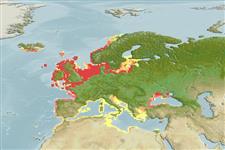分類 / Names
共通名の | 類義語 | Catalog of Fishes(部類, 種) | ITIS | CoL | WoRMS | Cloffa
Environment: milieu / climate zone / depth range / distribution range
生態学
海; 汽水性の 底生の; 海洋回遊性 (Ref. 51243); 深さの範囲 20 - 70 m (Ref. 6302). Temperate; 70°N - 30°N, 25°W - 42°E
Northeast Atlantic: throughout the Mediterranean and along the European coasts to Arctic Circle; also found in most of the Baltic Sea. Subspecies Psetta maxima maeotica in the Black Sea.
Length at first maturity / サイズ / 重さ / 年齢
Maturity: Lm 40.8, range 41 - 54 cm
Max length : 100.0 cm SL オス/雌雄の選別がない; (Ref. 4703); common length : 50.0 cm TL オス/雌雄の選別がない; (Ref. 35388); common length :70 cm TL (female); 最大公表体重: 25.0 kg (Ref. 9988); 最大記録サイズ: 25 年 (Ref. 32766)
Body almost circular. Eye side without scales but with large bony tubercles (Ref. 35388).
Adults live on sandy, rocky or mixed bottoms; rather common in brackish waters. Feed mainly on other bottom-living fishes (sand-eels, gobies, etc.), and also, to a lesser extent, on larger crustaceans and bivalves. Batch spawner (Ref. 51846). Spawning season is between April and August; pelagic eggs. May reach 25 kg (Ref. 9988). Highly esteemed food fish. Utilized fresh or frozen; eaten steamed, pan-fried, broiled, boiled, microwaved and baked (Ref. 9988).
Spawning usually happens between the months of February and April in the Mediterranean and from May to July in the Atlantic. Sequenced spawning every 2-4 days. Eggs have a single fat drop. Larvae are initially symmetric but, at the end of the metamorphosis (day 40-50, 25 mm), the right eye moves to the left side, losing its initial bilateral symmetry. Egg size 0.9 - 1.2 mm, larval length at hatching 2.7-3.1 mm.
Bauchot, M.-L., 1987. Poissons osseux. p. 891-1421. In W. Fischer, M.L. Bauchot and M. Schneider (eds.) Fiches FAO d'identification pour les besoins de la pêche. (rev. 1). Méditerranée et mer Noire. Zone de pêche 37. Vol. II. Commission des Communautés Européennes and FAO, Rome. (Ref. 3397)
Human uses
水産業: 商業; 水産養殖: 商業; ゲームフィッシュ: はい; 水族館・水槽: 公共の水族館
用具
特記事項
XMLをダウンロードして下さい
インターネットの情報源
Estimates based on models
Preferred temperature (Ref.
123201): 5.9 - 11.9, mean 9.4 °C (based on 239 cells).
Phylogenetic diversity index (Ref.
82804): PD
50 = 0.5645 [Uniqueness, from 0.5 = low to 2.0 = high].
Bayesian length-weight: a=0.01122 (0.00922 - 0.01365), b=3.06 (3.00 - 3.12), in cm total length, based on LWR estimates for this species (Ref.
93245).
栄養段階 (Ref.
69278): 4.4 ±0.0 se; based on diet studies.
Generation time: 4.8 (3.8 - 5.8) years. Estimated as median ln(3)/K based on 24
growth studies.
回復力 (Ref.
120179): 手段, 1.4年~4.4年の倍増期間の最小個体群 (K=0.15-0.28; tm=3-5; tmax=26; Fec=5 million).
Prior r = 0.50, 95% CL = 0.33 - 0.75, Based on 9 full stock assessments.
Fishing Vulnerability (Ref.
59153): High vulnerability (60 of 100).
Climate Vulnerability (Ref.
125649): High vulnerability (65 of 100).
Nutrients (Ref.
124155): Calcium = 28.5 [12.1, 48.8] mg/100g; Iron = 0.144 [0.058, 0.649] mg/100g; Protein = 19.5 [18.0, 21.0] %; Omega3 = 0.275 [0.153, 0.500] g/100g; Selenium = 14.1 [6.4, 33.9] μg/100g; VitaminA = 8.19 [2.10, 35.13] μg/100g; Zinc = 0.156 [0.092, 0.524] mg/100g (wet weight); based on
nutrient studies.
